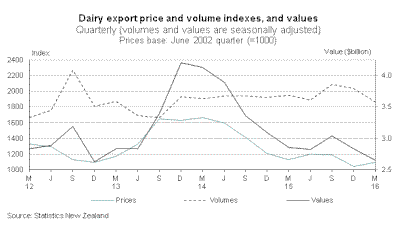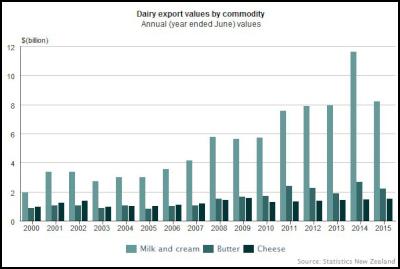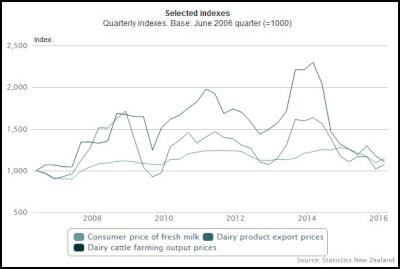Dairy prices down, from farm gate to grocery store
Dairy prices down, from farm gate to grocery store – Media release
10 June 2016
Global dairy prices have fallen over the last two years, meaning lower payments for farmers, and lower prices for consumers. This article provides an overview of the New Zealand dairy industry over recent years. It refers to data from price indexes and the agricultural production statistics.
Falling prices, rather than lower volumes, have pushed down the value of dairy product exports over the past two years. The value of exported dairy products fell $1.5 billion between the December 2013 quarter and the March 2016 quarter, down 37 percent.
The lower export value was driven largely by price, as the volumes of milk products exported have remained relatively steady.

The percentage of New Zealand’s annual export value that comes from dairy has generally increased over the last decade. However, in the most recent year from 2014 to 2015, it dropped from 32 percent to 26 percent of New Zealand’s goods exported. The main contribution to this fall in value was milk and cream, which includes milk powder. Butter also fell, while cheese rose 5 percent.

See Overseas Merchandise Trade: April 2016 quarter for more information on dairy export values and quantities.
Most of New Zealand’s dairy product exports are sold by Fonterra. Their forecast farm-gate milk price for the 2016/17 dairy season is currently $4.25 – well down from the peak of $8.40, in the 2013/14 season. The farm-gate price is what Fonterra pay to dairy farmers per kilogram of milk solids. According to Dairy NZ, for the average New Zealand dairy farm to break even, the price needs to be $5.25.
The prices dairy cattle farmers receive (the output prices) are at a nine-year low. They have fallen by more than half since the recent peak in 2014.

In the March 2016 quarter alone, the dairy cattle farming prices received (outputs) fell 6.0 percent, as measured by the business price index. By comparison the average price paid by households for the cheapest-available 2 litres of blue-top milk, as measured by the food price index, was $3.28 in March 2016. This is compared with the high of $3.71 in November 2014. Dairy export prices rose 5.1 percent in the March 2016 quarter, influenced by milk powder (up 4.2 percent).
Globally, the prices of dairy products have been falling in 2016. The global dairy trade (GDT) price index mostly fell in the March 2016 quarter, with some rises through April. The GDT however, represents a small proportion of dairy products exported by New Zealand. For example, the total volume of dairy products exported by New Zealand in the March 2016 month was 223,000 tonnes – the GDT only traded a total of 42,286 tonnes in the same period.
With lowered milk-solid payouts due to weak international demand and increasing global supply, the number of dairy cattle decreased in 2015, for the first time since 2005. Agricultural production statistics show there were 6.5 million dairy cattle at 30 June 2015, down 213,000 (3 percent) from the same time in 2014.
For more information on dairy output prices see Business Price Indexes.
For more information on dairy exports see Overseas Trade Price Indexes.
ENDS


 John Mazenier: Gaffer Tape And Glue Delivering New Zealand’s Mission Critical Services
John Mazenier: Gaffer Tape And Glue Delivering New Zealand’s Mission Critical Services Earthquake Commission: Ivan Skinner Award Winner Inspired By Real-life Earthquake Experience
Earthquake Commission: Ivan Skinner Award Winner Inspired By Real-life Earthquake Experience Reserve Bank: Consultation Opens On A Digital Currency For New Zealand
Reserve Bank: Consultation Opens On A Digital Currency For New Zealand NIWA: Ship Anchors May Cause Extensive And Long-lasting Damage To The Seafloor, According To New Research
NIWA: Ship Anchors May Cause Extensive And Long-lasting Damage To The Seafloor, According To New Research New Zealand Customs Service: A Step Forward For Simpler Trade Between New Zealand And Singapore
New Zealand Customs Service: A Step Forward For Simpler Trade Between New Zealand And Singapore Horizon Research: 68% Say Make Banks Offer Fraud Protection
Horizon Research: 68% Say Make Banks Offer Fraud Protection



